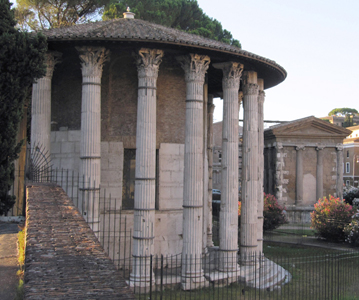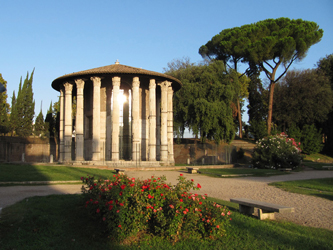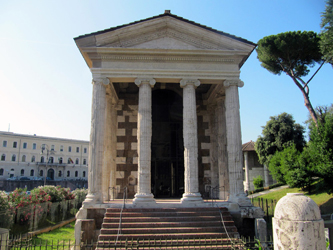SUN AN’ SOUL - DREAM AN’ ROME
TEMPLE OF HERCULES VICTORIOUS AND TEMPLE OF PORTUNUS
 |
Temple of Hercules Victorious and Temple of Portunus
click to enlarge |
The Temple of Hercules Victorious and the Temple of Portunus are located in the ancient Forum Boarium. The name of Forum Boarium (=cattle) was due to the cattle market that was held in the square of the Forum.
The round temple, such as those dedicated to the goddess Vesta, built around 120 BC and dedicated to Hercules Victor, is particularly interesting because it is the oldest marble Roman monument that has been preserved. In the Middle Ages the temple was transformed into a church, what saved it from spoliation. It remained a church until the early 1800s when the famous architect Giuseppe Valadier returned it to its original form.
 |
| Temple of Hercules Victorious - click to enlarge |
The cult of Hercules was particularly practiced in the Forum Boario, here it was found, miraculously survived to the fusion, the bronze statue of Hercules exposed in the Capitoline Museums.
Next to the temple of Hercules Victor stands the Temple that in the Republican era, was dedicated to the god Portunus, protector of ports: in fact it was adjacent to the most ancient port of Rome, near the Ponte Emilio, now known as Ponte Rotto (=broken).
In the Middle Ages, Portuno was abandoned, the temple became the church of St. Mary of Egypt, the patron of prostitutes (repent). Inside the temple are preserved frescoes representing episodes in the life of the saint.
 |
| Temple of Portunus - click to enlarge |
In the ancient temple is well preserved part of the trabeation (the structure that rests on the column capitals, consisting of architrave, frieze and cornice). In front of the temple of Portuno, we see Casa Crescenzi, an ancient noble house of the Middle Ages, built incorporating refined antique marbles, probably dating back to the Severian era (200 AD).
back |

